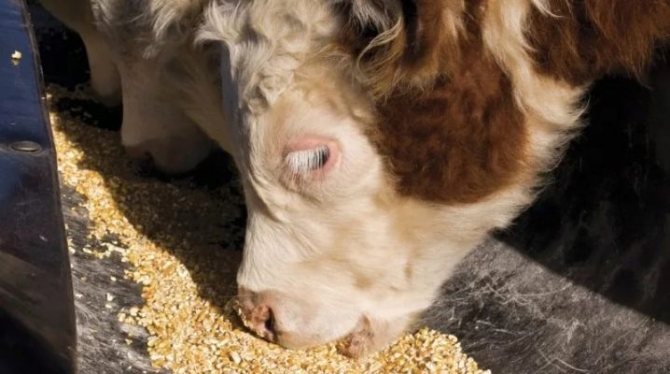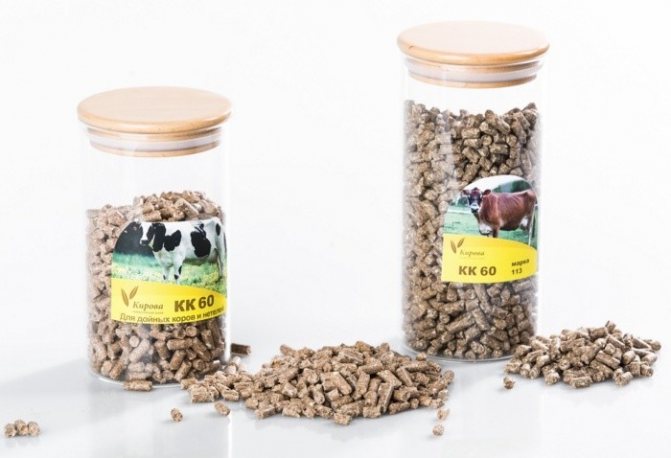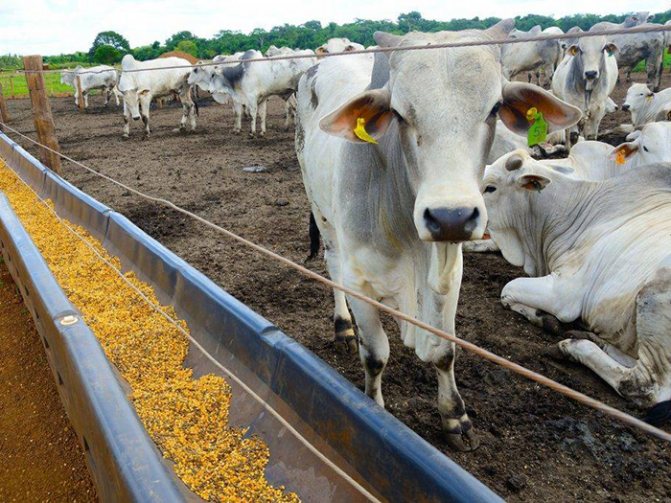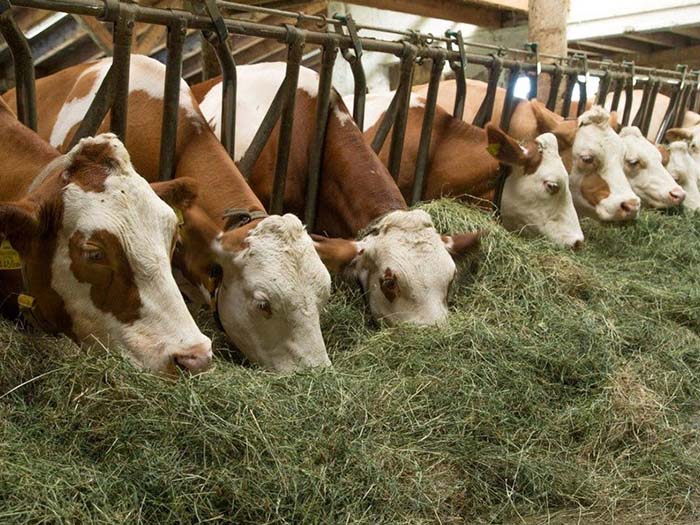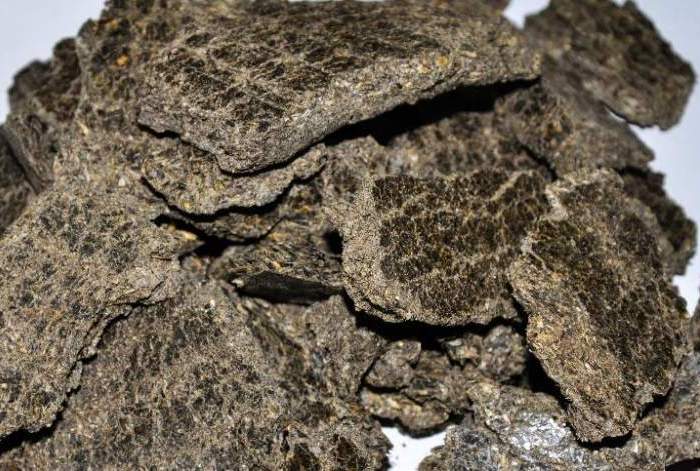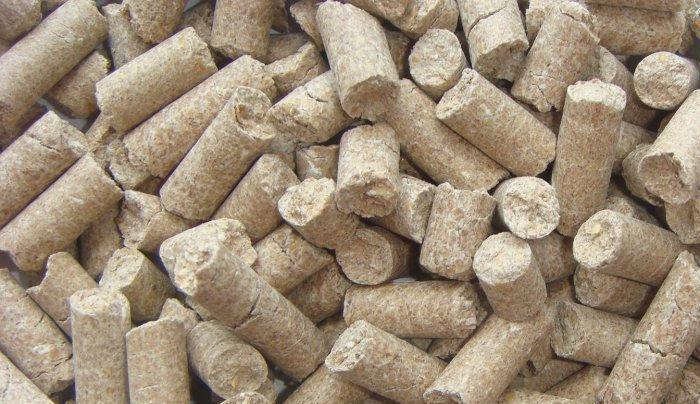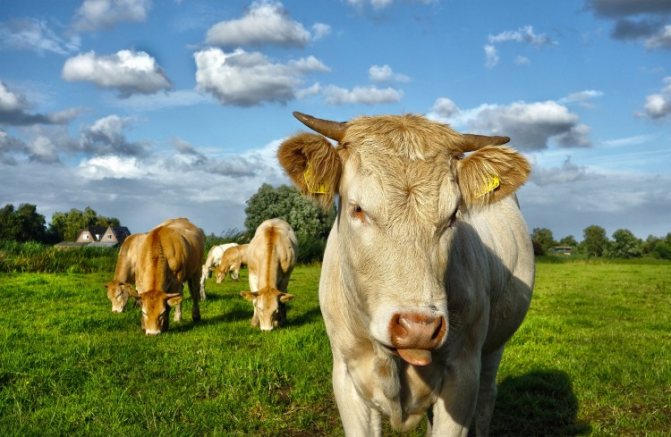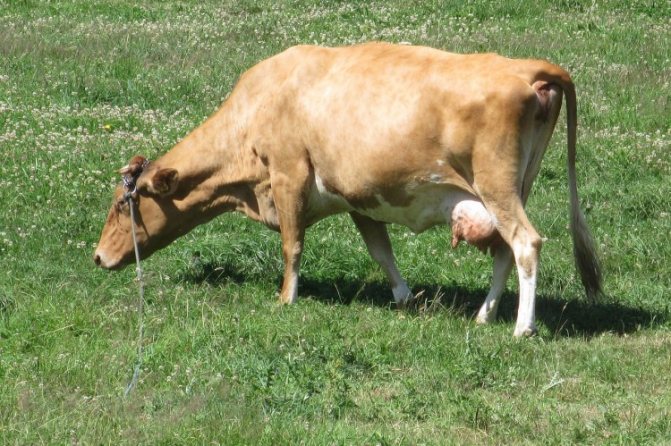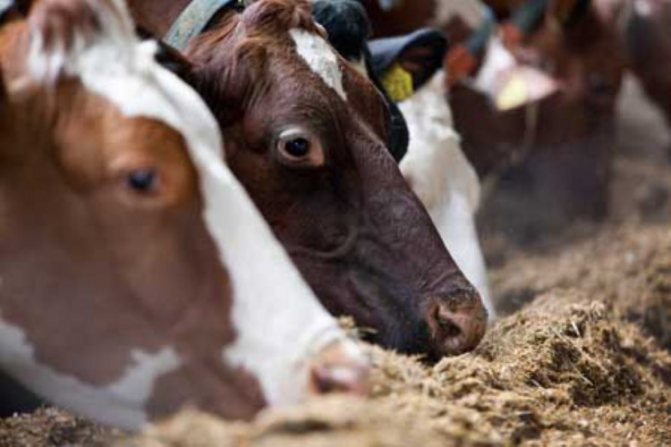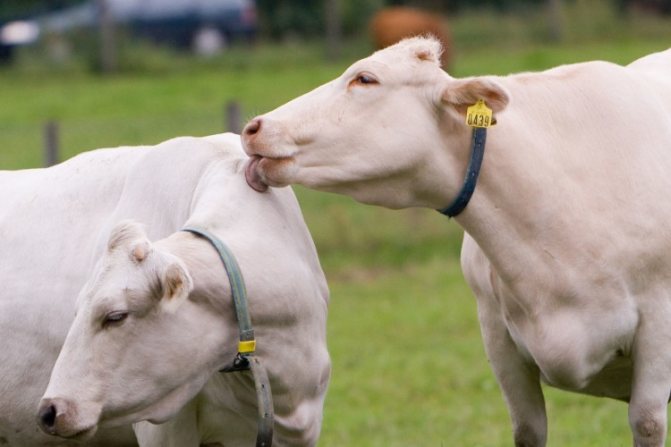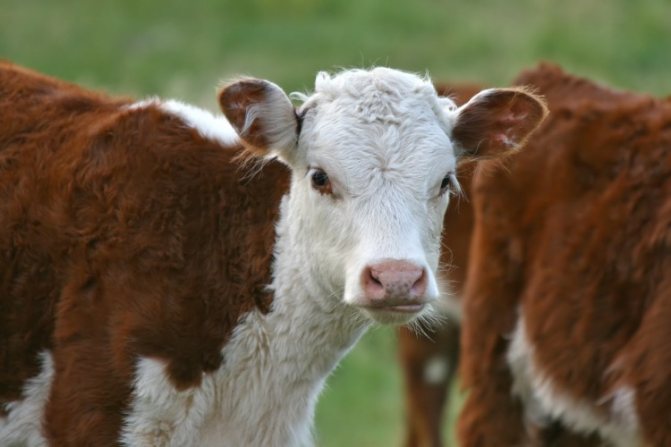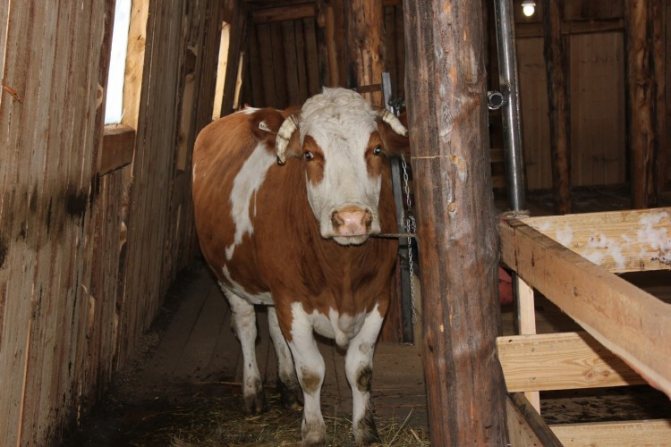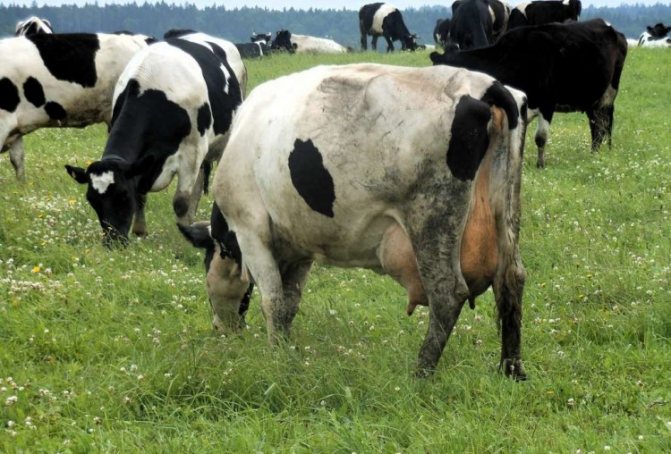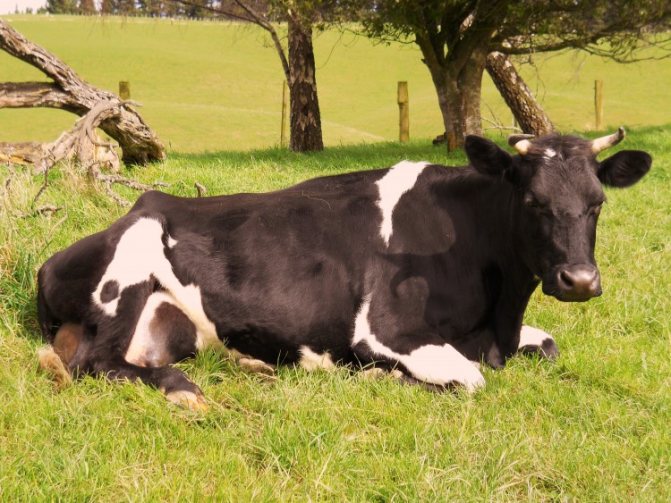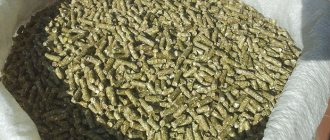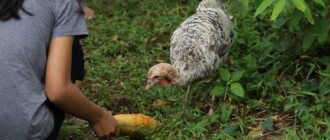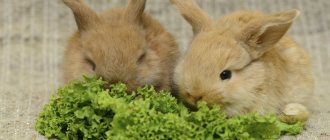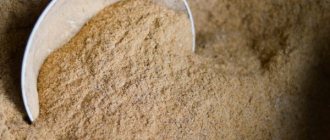Meat, meat and dairy and dairy breeds of cows bring different types of products... But in order to receive both meat and milk, it is important to properly organize the feeding regime and compose the diet of the animals.
In the process, it is necessary to take into account the characteristics of the variety of livestock, the climatic conditions of breeding, as well as the age of the animals. At the same time, the daily menu must be made the most balanced by adding premixes to the feed. For dairy cows, the milk yield will depend on the quality of the diet, for meat cows - the volume and quality of meat. This article will tell you how to correctly solve the assigned tasks in feeding.
What it is?
Compound feed for cattle is a combination of various substances that are needed to feed animals. Selected components are carefully cleaned, crushed, and then compose the feed mixture, guided by proven recipes. A large part of the compound feed invariably falls on cereal grains. They are the basis of the feed mixture. The key requirements for the preparation of each type of compound feed are recorded in the corresponding GOST.
All such products, with rare exceptions, are manufactured on an industrial scale. Only a few farms prepare compound feed themselves. Usually, additional equipment is used for this, which greatly limits the possibilities of handicraft production. Combined feed factories can leave in the form of:
The mixtures are not the only food for animals, but only an addition to the main diet. Their role is to provide vitamins, minerals and proteins. Such additives accelerate growth and reduce morbidity, increasing the productivity of livestock. Usually, for each type of animal, a mixed feed is selected separately.
Important: it is categorically impossible to give cattle compound feed intended for birds.
What grass is dangerous for cows
In the form of grass and hay, a cow can do anything except poisonous grasses. In our region, there is a red and black nightshade, henbane (generally deadly).
It is interesting(!):
Unlike cows, goats can consume certain types of poisonous plants without harm to their health - the same nightshade or fly agarics. For a cow, such a meal would be fatal.
If you are unsure of which poisonous herbs are common in your area, ask other cow owners, farmers, or your veterinarian.
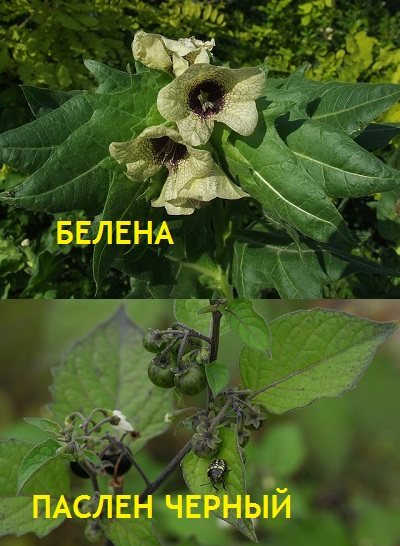
Black nightshade and henbane are dangerous for the cow
Structure
The thematic tables indicate that combined feeds are made from:
- cereal grains containing a lot of carbohydrates, such as wheat, oats, barley;
- protein-rich legumes (peas, beans, lupine);
- oil plants (sunflower, rapeseed, rape);
- hay;
- straw;
- vitamin supplements;
- mineral inclusions;
- by-products of grain processing.


Often, compound feeds are made universal, that is, they are intended not only for cattle, but also for other animals, including poultry. One of the recipes for such food contains (in decreasing order of proportion):
- barley - not less than 41%;
- corn - at least 29%;
- oats - not less than 19%;
- wheat - at least 7%.


The complete feed type has a symbol PC. This type of food is designed to improve the digestion of livestock, increase their productivity and improve health.Kon) contain a significant amount of microscopic additives, proteins and minerals. Concentrated feed becomes an addition to the usual diet and is used in limited quantities. The abbreviation BVD stands for mixtures of proteins, vitamins and minerals.
Additionally it includes:
- trace elements;
- amino acids;
- taste improvers;
- means for strengthening the immune system.
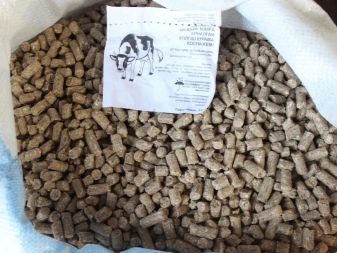

Calf pre-start feed is very important. The fact is that it is he who determines the full development of the immune system and the formation of other organs. The prelaunch group includes those foods that are intended for the first 3 months of development. Such food is equally good for the development of both beef and dairy cattle. Important: when prestarters are used, it is necessary to guarantee unhindered round-the-clock access to water.
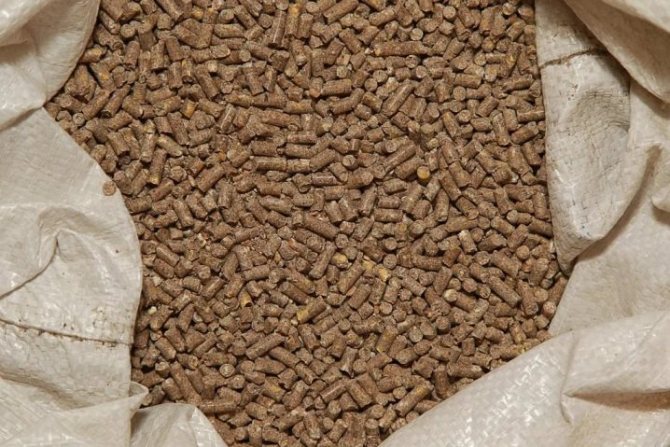

At the age of 6 months and older, feeds in the "start" category are hardly suitable. In this case, a more varied diet is required. The digestive system of the animal has already formed and can digest rather coarse food. For dairy cows, feed is used that:
- increase milk production;
- increase the concentration of protein and fat components in it;
- prolong the time of productive use of livestock.
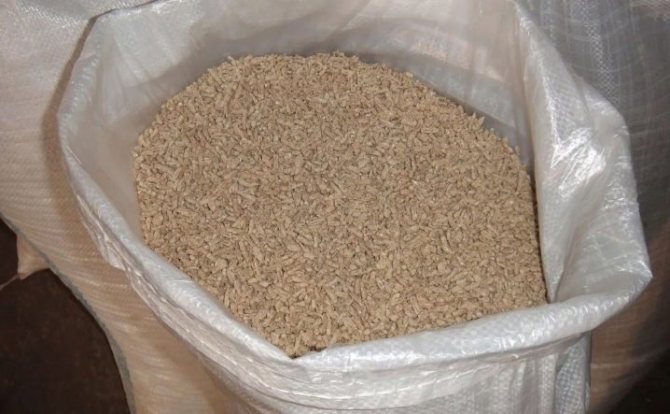

You can buy feed, compound feed and feed additives from us:
Feed for cows
Feed and compound feed
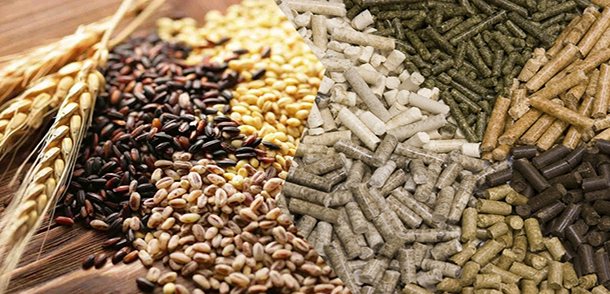

Feed additives
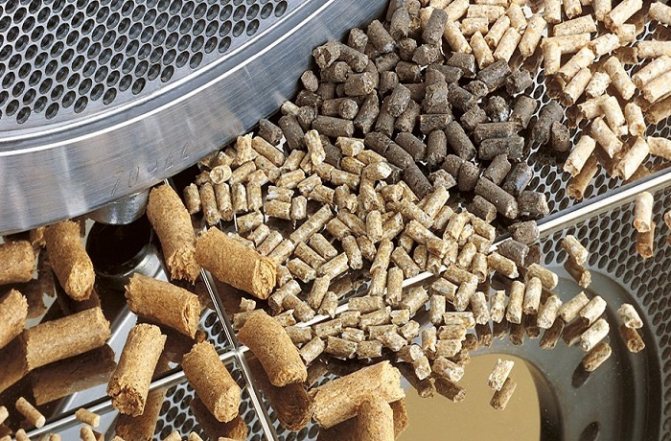

A well-designed full-fledged cow feeding system not only contributes to an increase in milk yield or reproductive performance, but also to an intensive growth of the meat group.
Features of feeding at home
Manufacturers
The Russian market for combined feed is distinguished by a high concentration of production. In 2020, the 20 largest companies in this area, which control 56 harvesting sites, produced over 48% of the total volume of all compound feeds in the Russian Federation. The undisputed market leaders that you can trust are the companies:
Both wholesale and retail supplies are made by the Gatchina feed mill. The company's products include feed of classic and innovative formulations. Important: many manufacturers have not one, but several brands.
To choose the right feed, you need to focus not so much on them as on the chemical composition of the product. The recommendations of veterinarians and the feedback from other farmers should be taken into account.
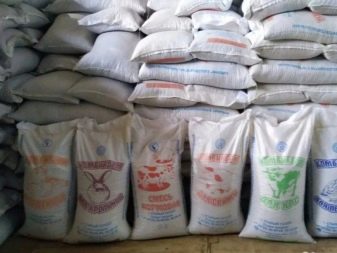

How to give?
Whatever compound feed is used, you need to give it strictly "according to science." That is, in accordance with the standards of maintenance, worked out over many decades. Calves are comfortable eating the combo feed from 4 days of age. The pre-starter composition is usually oatmeal jelly. By the end of the first week, the daily dose is 0.15-0.2 kg of feed.
Then this amount is systematically increased. Older calves can be given up to 2.5 kg of the mixture per day. Important: when using both artisanal and factory feed preparations, they are given to dairy calves only in a liquid state. Respiratory cramps may occur due to granules or powder. In the first 3 months of life, the recipe for compound feed for cattle is universal.


Then supplements are supposed to be used either to increase milk production or to build muscle mass. Of course, it is also required to take into account the characteristics of individual breeds and conditions of detention. The amount of compound feed can vary depending on the activity of the animal. It is influenced by the actual weather (for pasture maintenance). In the younger age group, it is required to take into account whether the calves are sucked and fed back or fed with whole milk.
Attention: it is unacceptable to use damp compound feeds of both factory and handicraft production.
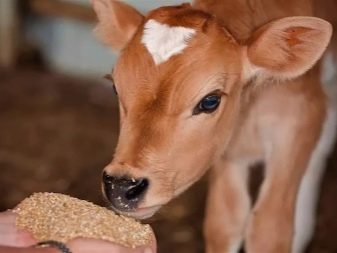

How much feed a dairy cow needs per day is determined taking into account overall productivity. Usually, in terms of 1 liter of commercial milk, 0.2-0.4 kg of combined feed is consumed. A more accurate figure cannot be named without taking into account the condition of the animal and its total mass. For individuals of both dairy and meat direction, it is advisable to add root crops to the diet.
As soon as calving occurs, vitamin sets are also added to the food. The volume of the diet is increased smoothly. Animals should be taught from childhood to a clear diet. Overeating should not be allowed. All leftovers from the feeders are regularly removed and replaced with a new feed mixture.
After a while, you can use a complete cow feed with added proteins. Such a solution will help to increase milk yield and quickly restore the body.
Attention: concentrated mixtures should make up a maximum of 50% of the total food.
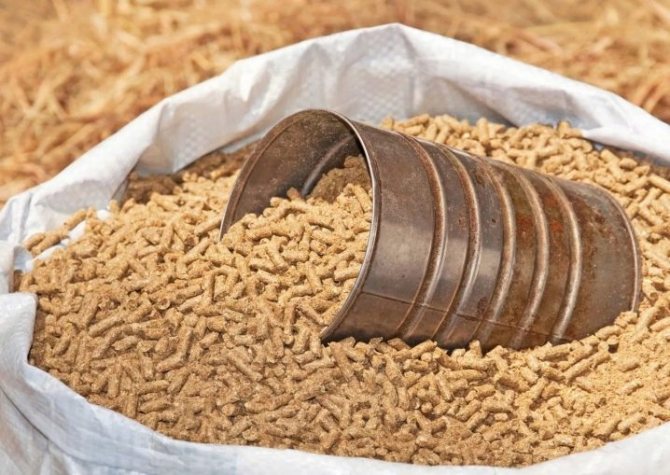

If the farm contains no more than three cows, you can prepare compound feed yourself... At the same time, recipes are selected at their discretion. It is recommended to add to them from 20 to 30% of vitamin complexes. By using premixes, milk production can be increased.
Protein feed is used not earlier than the second month of the animal's life. This approach will allow the calves to develop their muscles more quickly. In addition, protein supplements are essential for marbled meat.
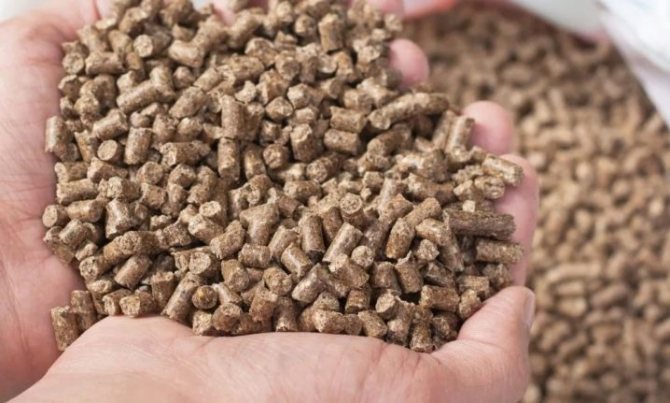

Beef cattle, starting from the third month of life, should, in addition to compound feed, receive traditional juicy feed. For the cold season, the proportion of concentrates containing vitamins and probiotic substances does not exceed 10%. Grain feed premixes help to maximize the weight gain. Their volume is determined according to the age of the animals. At six months of age, calves need 3.5 kg of feed, and at the age of 60 to 90 days, the proportion of fattening will be 0.6 kg per animal.
Why is it important to know how much feed a cow is eating?
We can calculate a perfectly balanced diet. But it will remain so only on paper if we do not know how much feed the animals actually eat. Let's look at an example. According to calculations, to obtain milk productivity at the level of 30 liters, an animal must eat 20 kg of dry matter per day. But if you do not control the actual eating of food, then the technologist remains blind, he does not understand what the animal is actually receiving. And what if this figure is actually only 13.5 kg? In our example (see tables below), the animal will receive less than 42 MJ PEL, 907 g of assimilated protein and will be able to reach a productivity of 17 kg instead of the planned 30 kg.


Another common mistake is feeding cows with very wet, voluminous feed. Returning to the previous example, 8 kg of 30% DM corn silage contains 2.4 kg dry matter. And the same 8 kg of silage with an indicator of 20% DM - only 1.6 kg of dry matter.
So, an objective control of feeding and a systematic increase in productivity can be carried out only by knowing the amount of dry matter in feed raw materials and the actual consumption of dry matter by animals.
Recipes
No matter how good the factory compound feeds are, they have one drawback - such products are expensive for cattle. Buying them forces you to lose a lot of money. Therefore, the question naturally arises about the possibility of preparing compound feed at home. And the answer depends on how many animals you need to feed.
For 2-3 individuals, it is quite possible to prepare a diet with your own hands. But already a professional farming enterprise will not be able to do with such blanks.


When preparing feed for cattle, you do not need to lay as much grain as for feeding birds. The main component is barley or ground corn. Additionally add:
- meal;
- sunflower cake;
- wheat bran;
- tricalcium phosphate.
The addition of calcium and phosphorus is necessary for the normal development of the musculoskeletal system of animals. Having mixed the prepared components, it is required to grind them to a homogeneous state in a grain crusher. It is recommended to use a steel mesh with cells of 0.003x0.003 m. Adult animals require slightly more barley stalks and wheat bran than young animals. By reducing the amount of meal or cake, you can raise the milk yield; increasing - to accelerate the development of muscles.
Regardless of the nuances of the recipe, tricalcium phosphate is included in the amount of 0.6% (for adults) and 0.3% (at an early age). When fattening calves, sometimes the amount of barley in the total composition is increased, while the bran is used the same amount. Some individuals reject both bran and stems. The exit turns out to be thorough (to the state of crumb) grinding. It is useful to add meal to support the growth and formation of the skeleton.
An alternative method involves the use of feed grains. To replenish the diet of animals with fiber, use herbal flour. The total amount of fiber should account for 20 to 25%, then the cow will feel satisfactory. A complete alternative recipe for mixed cow feed is as follows:
- 25% herbal flour;
- almost the same amount of sunflower meal;
- 20% barley;
- 15% ground corn and wheat bran;
- 0.5% table salt.
See below for compound feed for cattle.
Currently, dry compound feeds and mixtures occupy a significant place in the diet of domestic animals, partially or completely replacing traditional plant foods. The use of such concentrates has rather great advantages. The composition of feed for cattle contains all the substances necessary for the development of animals, while working with such feed is much more convenient.
The specifics of hay making
The quality of dry grass harvested for the winter depends on the correct organization of haymaking.
- High quality hay will be obtained if it is harvested early in the growing season. Young grasses are more nutritious, as they differ in foliage. The leaves account for 40-50% of vitamins and other trace elements.
- Older plants have fewer leaves, their digestibility decreases, and more waste remains.
The grass stand changes very quickly. There are optimal harvesting periods for each haymaking option. In leguminous grasses, this is the onset of budding, and for cereals, the beginning of the appearance of an ear. With flowering, a transitional period begins. Harvesting results in a low nutrient content of the hay.
The determining factor for timing is dry and clear weather. In the event of rain or dew, the drying of the hay increases, which also leads to the loss of nutrients.
Tedding helps to reduce moisture in hay. There are special mechanical roller rakes for work.
The color of the hay is indicative of its quality. A properly dried herbage is considered green. However, the shades may be different:
- cereals - gray greens;
- sour herbs - intense greens;
- legumes - brown greens;
- alfalfa is a bright green.
If the technological conditions for mowing and storage are violated, hay will be:
- whitish (lying in the sun for a long time);
- light yellow (caught in the rain);
- dark yellow or brown (rotted hay).
What is compound feed for cattle
Compound feed is a mixture of feed of plant and animal origin, which includes the whole complex of nutrients necessary for the development of animals in a certain concentration. The use of this type of feed makes the diet as balanced as possible.
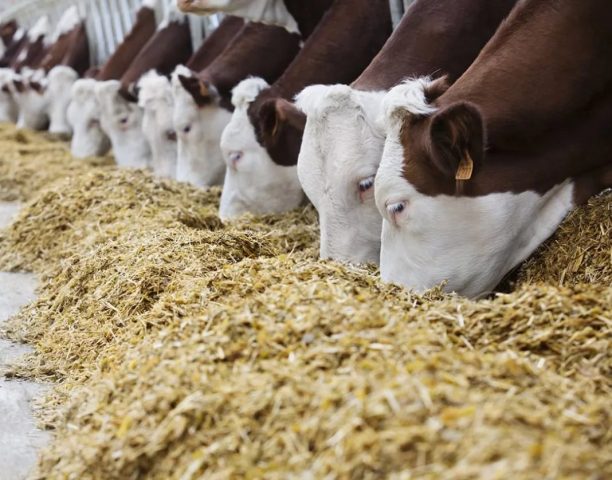

Combined feeds are divided according to their purpose into several groups, depending on the following factors:
- type of cattle;
- age;
- growing directions (meat, dairy);
- herd productivity.
Pros and cons of feed mixtures for cattle
The use of compound feed for use in the diet of cattle has a number of positive aspects. These include:
- Convenience of work, storage and transportation.
- Economical compared to traditional feed.
- Balance, the ability to include the necessary elements in the composition.
- Environmental friendliness, safety in terms of compliance with sanitary and hygienic standards.
- Possibility to give any kind of feed (granules, powder, briquettes).
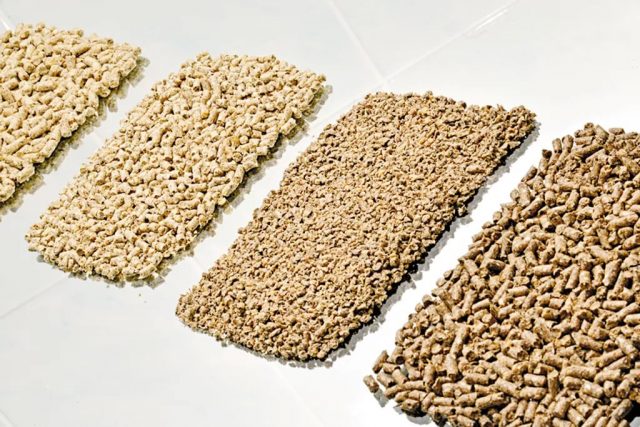

Feeding cattle with compound feed provides better results compared to conventional feed, herd productivity increases by an average of 10-15%. Due to the balanced nutrition, a strong livestock grows, healthy offspring with good immunity are born. The negative aspects of using compound feed for cattle are the following:
- Higher price compared to conventional feed.
- The need to accustom animals to such a diet from a young age, since an adult livestock may not accept such food after the traditional one.
- The complexity of self-production, the need to use special equipment.
- The need for constant monitoring of feed dosages.
Is it possible to give a cow wheat
Wheat contains a lot of gluten, which makes it difficult for cattle to digest, therefore, its diet should not contain more than 10-15% of the rest of the grain feed.
Let's take a concrete example: 500 kg of a cow, average condition, not pregnant, lactating (20 liters of milk yield). An approximate daily budget menu will look like this:
- 12 kg of hay;
- 7 kg of potatoes, 4 kg of apples;
- 2 kg of bran, 2 kg of sunflower meal, 1.5 kg of corn, 1.5 kg of barley, 0.5 kg of wheat.
I recommend giving concentrates only in dry form. Moistened, steamed deteriorate quickly and a lot of waste remains.
Types of compound feed for cattle
Quite a lot of compound feed for cattle is produced. They are divided according to their purpose into the following types:
- For calves.
- For cows.
- For breeding bulls.
Combined feeds differ and the form of release. For ease of use, compound feed for cattle is produced in the form:
- homogeneous free-flowing mass;
- pressed granules;
- briquettes.
Loose feed is not subjected to pressing and heat treatment, so they have the shortest shelf life. Such food mixtures are made immediately before use, adding and grinding all the necessary components.
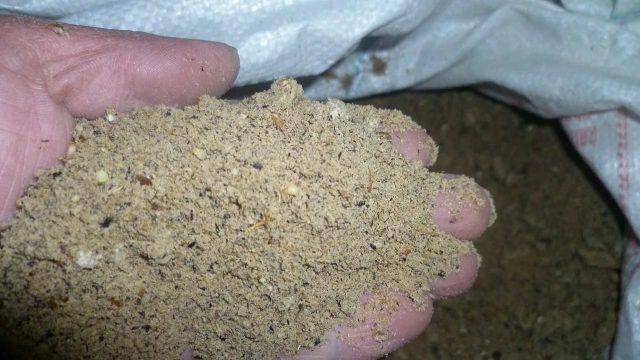

Granulated feed for cattle and its constituent components are exposed to temperature and pressure during the preparation process, due to which the individual nutrients contained in it break down into simpler and more easily digestible ones. At the same time, pathogenic microflora and pathogens are destroyed. Granulated compound feed can be stored for a long time. Compound feed in briquettes differs from granulated feed only in larger forms of release. Before use, the briquettes are crushed to the desired consistency, and then fed to the animals.
The feed mixtures also differ in their composition. Compound feeds of the complete diet (PC) include a full set of nutrients, vitamins and mineral supplements, therefore, when using them, other feeds are not used. Concentrated compound feeds (K) are used as an addition to the diet of roughage and succulent feed and are processed grain products. Premixes (P) and protein-vitamin supplements (BVD) are used to supplement the diet with the necessary set of trace elements and are added to feed in small quantities.
Processing pumpkin, squash and other vegetables with seeds before feeding
Ripe seeds need to be removed, the peel is too hard, otherwise they can clog the book. Before feeding, the vegetables are cut into pieces that will freely pass through the cow's esophagus.
It is best to use a feed cutter or chop, but the size of the pieces will be different for everyone, as well as different eating options for different cows.
From experience (!):
My cow somehow choked on a piece of pumpkin about 7 by 8 cm, while eating larger pieces is quite normal. I had to push the stuck piece deeper to get it into the proventriculus.
Composition of compound feed for cattle
Depending on which groups of cattle the compound feed is intended for, its composition also changes. This is due to the fact that at different stages of development, animals require different amounts of certain nutrients. The main component of all compound feed is grain and its processed products. In addition, a granular cattle feed recipe may include:
- meal and cakes of various oilseeds;
- roughage (straw, hay);
- legumes;
- TMV (vitamin-herbal flour);
- coniferous flour;
- meat and bone or fish meal;
- vitamin and mineral premixes.
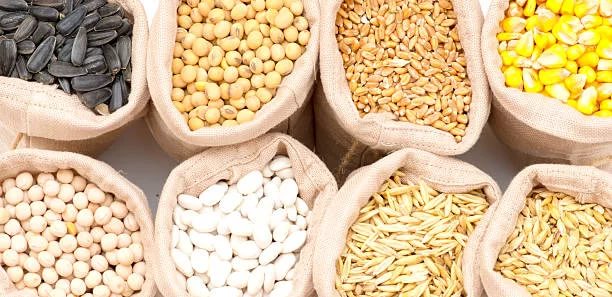

Composition of compound feed for calves
Young animals are the most vulnerable part of the cattle population. Therefore, special attention must be paid to feeding this group of animals. Nutrition should provide fast weight gain, as well as strengthen the immunity of animals, so that a well-developed healthy herd can be formed in the future. The composition of the combined feed for calves must include the following components:
- protein;
- cellulose;
- amino acids;
- vitamins;
- antioxidants;
- enzymes.
Below in the table are several options for the percentage of starter, combined dry feed for calves up to 6 months of age.
Among cattle keepers, the use of combined feed in the diet of animals is popular. The composition of compound feed for cattle allows the animal to be provided with all the substances necessary for growth and development. Since the composition of compound feed is based on the research of agricultural scientists and ecologists, we can safely say that this is the best option for feeding livestock.
You can read all about the bonding of cattle in our article. - here.
Forms of production of compound feed for cattle
Depending on the needs and preferences of each independent breeder, he can choose the form of release that suits him best. At the moment, there are three forms of production of combined feed:
- Loose compound feed is a more or less homogeneous mixture of crushed components. Depending on the degree of grinding, it can be fine, medium or coarse. It is the least expensive to manufacture and, accordingly, the cheapest option.
- Granulated compound feed is obtained by pressing loose feed into cylindrical granules ranging in size from 5 to 19 mm. They are more convenient in storage and transportation, adapted for mechanized feeding to animals, which is especially important for large farms. In addition, during pressing, the risk of pathogens entering the feed decreases, and the substances themselves that are part of the compound feed break down into more easily digestible ones, without losing vitamins.
- Briquetted compound feed is more acceptable for use in large-scale livestock farms. It is a product compressed into relatively large bars. This makes it more convenient to move and store it, however, before feeding into the trough, the briquettes should be chopped in portions.
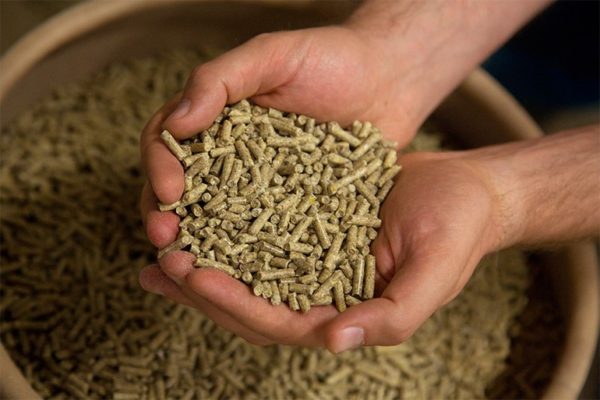

The granular form is the most convenient for subsidiary plots and farmers
Content and composition of the main types of feed


Compound feed for animals is always chosen individually. The age, food group and type of animal are taken into account. Layer feed will differ from broiler feed. There are also significant differences in the formulations for pigs and broodstock feeding. When fattening cattle, preference is given to the concentrate type of feeding (the proportion of concentrates is 60–75%).It is important to pay attention to the nutritional value of the diet and the percentage of protein. Foods with a low protein content are of lower quality, as they cannot meet the body's need for this important element.
Herbal flour is added to the composition of animal feed. It is a source of fiber, which ensures the normalization of digestion processes, and at the same time a vitamin supplement. However, its content in the recipe should not exceed the accepted standards. For each biological species of farm animals, they will be different.
Cattle feed recipes
In various sources, you can find recipes for compound feed, which will indicate the percentage of the required ingredients, as well as the nutritional value of the resulting mixture. Each recipe is accompanied by information on the content of various substances (vitamins, micro- and macroelements, organic substances).
An instruction for the preparation of compound feed has been developed, according to which a unique number is assigned to each recipe. This rule greatly simplifies the search for the desired compound feed recipe. Thus, all cattle recipes will start with a number between 60 and 69.
The table below shows that each type of feed has its own advantages. The prescription compound feed combines the virtues of each.
Table # 1. Distribution of nutritional value by groups and types of feed
| Feed group | Feed type | Energy (J, Kcal) | Protein | Crude fiber |
| Legumes | Cereals | + | — | — |
| Corn | + | — | — | |
| Legumes | + | ++ | +- | |
| Food by-products | Flour, bran | — | +- | + |
| Dry pulp, molasses | +- | — | +- | |
| Yeast, bard | +- | + | +- | |
| Oils, meal, cake | +- | ++ | +- | |
| Animal products | Milk products | ++ | + | — |
| Fish flour | ++ | ++ | — |
Depending on which number is at the beginning, you can get more information about this recipe. So, if the recipe starts with 60, then it is intended for dairy cows. The number 61 at the beginning of the recipe indicates that it is intended for pregnant dry cows, the number 62 - for calves aged from one month to six months, 63 from six months to a year, 64 - from one to one and a half; 65 - for cattle in the feeding stage, 66 - for inseminating bulls.
Step-by-step instructions for the preparation of compound feed
Having chosen the right recipe, the breeder can prepare the compound feed on his own. This can be done using mini-mixers or manually.
Step 1
Purchase all the ingredients you need. As a rule, the components of a combo feed for cattle are corn, oats, fish meal, sugar, calcium phosphate, salt, premix, peas, meal, urea, grass meal, wheat bran, molasses, chalk, yeast, magnesium oxide, eprin, soy, barley. When these ingredients are combined in the correct proportions, you get food that meets the nutritional value of the needs of an individual at a given period of its life.


Cereals and legumes - the basis of compound feed
Step 2
All components of the future feed are crushed into small granules, but not into powder.
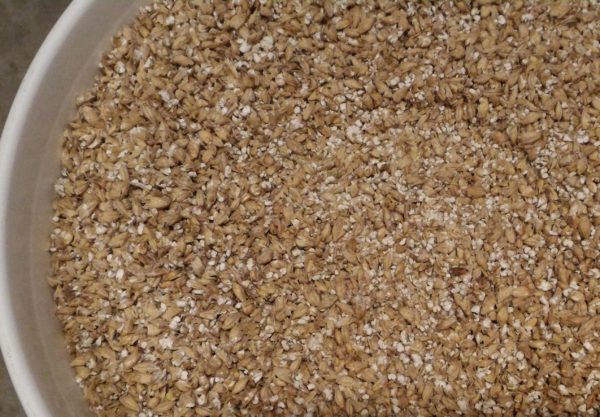

Grinding may require a crusher
Step 3
In a separate container, the main ingredients are mixed in the following order: cereals, legumes, bran, meal (cake).
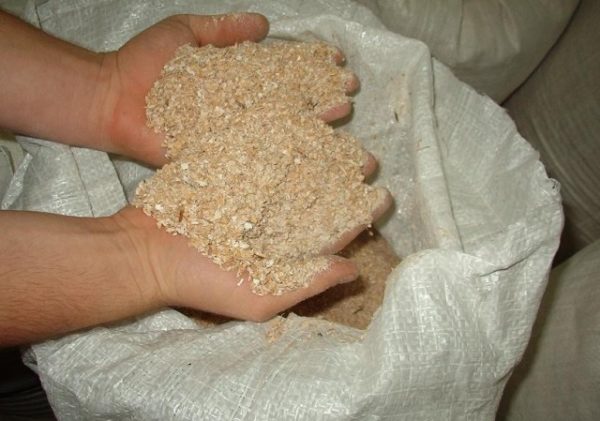

This mixture contains the main energy and nutritional value
Step 4
In another container, mix the vitamin and mineral components - premix, salt, flour, chemical additives.
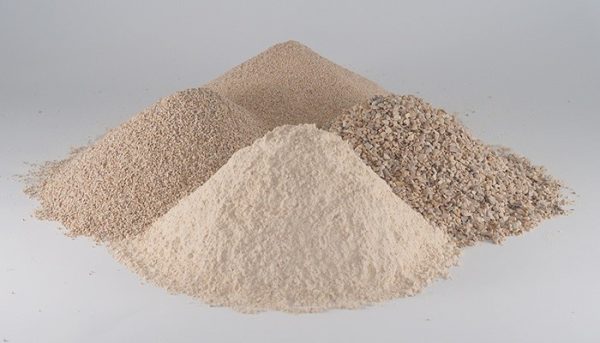

These additives will significantly increase the quality and efficiency of the compound feed.
Step 5
Mix both parts of the compound feed. If the recipe contains a liquid component, pour it in at the same time as stirring.
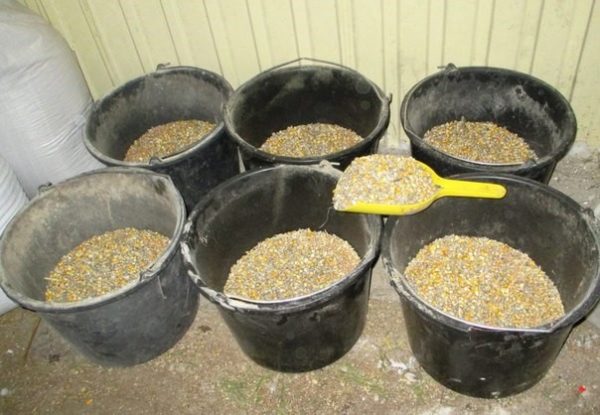

Homemade compound feed is ready to use
Video - Preparing cattle feed
Composition of compound feed for cattle
The composition of the compound feed is selected depending on the breed of the animal, its age category, biological state, the purpose of growing and productivity.The composition of each independent type of compound feed is scientifically substantiated, all components are selected exclusively from the needs of the individual in a given period of its existence.
The largest part in any compound feed, as a rule, is occupied by cereals. It can be wheat, barley, oats, corn, etc. The main function of cereals is to increase the mass and provide the animals with energy. It is due to this component that the cattle gains weight. Cereals are the carbohydrate component of the feed. They also contain vitamins and micro- / macroelements, which is also taken into account when determining the proportion of cereals in the composition of a particular feed.
The protein component is peas, forage legumes and sweet lupine. All of these foods are a source of crude protein. It is especially important for dairy cows. A more capacious source of protein is meal (most often soybean, rapeseed or flaxseed meal is used).
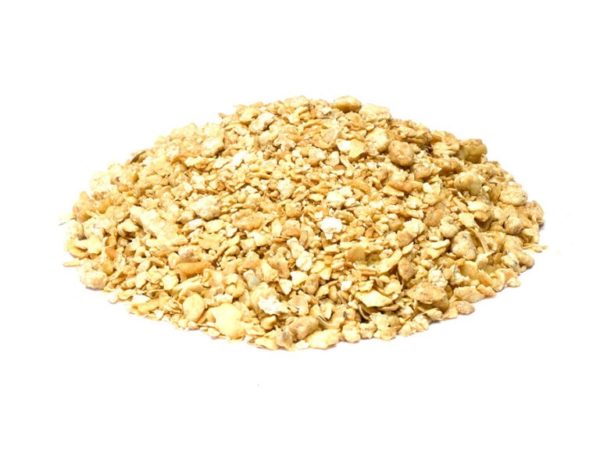

Soybean meal is one of the most popular protein components
Soybean meal is a fibrous part of soybeans obtained in the process of their extraction, with a fat content of up to 5%. In addition to its main function of providing animals with protein, soybean meal also serves as a source of vitamins and minerals. The content of Cu, Ca, P, S, Mg, K, Fe, Mn, Zn, Co, I is high in this product. Vitamins A, B1-B5, D, E are found in soybean meal.
Soybean meal is widely used in the manufacture of compound feed due to its easy digestibility, energy intensity, and high nutritional value. Also important is the rapid weight gain of animals using this product, their high immunity. Most cattle eat mixed feed with soybean meal very willingly, as they like its smell.
Is it possible to give a cow cabbage
A cash cow does not need to be given cabbage, regardless of its variety.
: white, colored, red or others.
The nutritional value of cabbage is low. In addition, it disrupts digestion and spoils the quality of milk (it acquires an unpleasant taste and smell).
Tip (!):
When there is surplus cabbage, it is better to ferment them, as we ferment ordinary cabbage. In the stall period, it will be by the way, as it contains vitamins and acids necessary for the functioning of the stomach.
Combined food option
The combined feed option provides for the use of combined feed. Such feeds are subdivided into full-feed (PC), concentrated (C), additives (BVD) and premixes (P).
Complete feeds are designed to provide the animal with all the substances necessary for normal growth and development, as well as to reduce feed consumption compared to natural counterparts.
Concentrated feeds differ from complete feeds with a higher content of a certain type of substance (for example, protein, micro- / macroelements, vitamins). These feeds are given to the most productive animals to replenish their nutrient inputs.
Supplements are served to animals along with the main feed in order to saturate their body with certain substances. Most often these are proteins or vitamins.
Premixes are ultra-concentrated additives that are introduced in small amounts into roughage to enrich them with certain substances.


Compound feed - for all occasions
Feeding adult cattle
For feeding adults, compound feeds are suitable, the number of which begins with the numbers 60, 61 or 66, depending on the type, period of life, sex and weight of the animal. For example, recipe K 66-1-89 is suitable for breeding bulls, and K 60-31-89 for cows for the stall period. Separately, it is worth considering the productivity of dairy and beef cows when selecting the optimal feed option.
Over time, the feed should be changed - for example, a pregnant cow needs other substances after calving than before. Also, a reason for changing a prescription can be a disease, an identified deficiency of a certain substance, a transition to another age or weight category.In such situations, not only the type of feed is changed, but also the size of its portion.
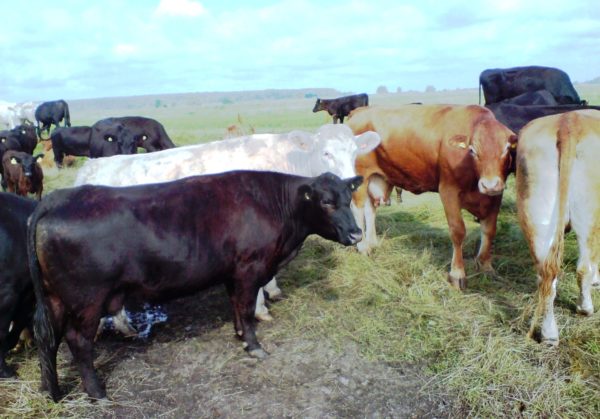

Healthy animals are the result of proper care and feeding
Features of feeding young animals
Young individuals are characterized by rapid growth and development, which explains some of the features of their feeding.
First, as the animal grows, the portion size of the feed increases steadily. Secondly, young animals very quickly move into new age categories. So, in just a year and a half of life, an animal changes at least three types of food. In addition to the above features, for young individuals the same rules apply as for adults: the diet requires adjustment in case of illness, exhaustion, weakened immunity and other factors.
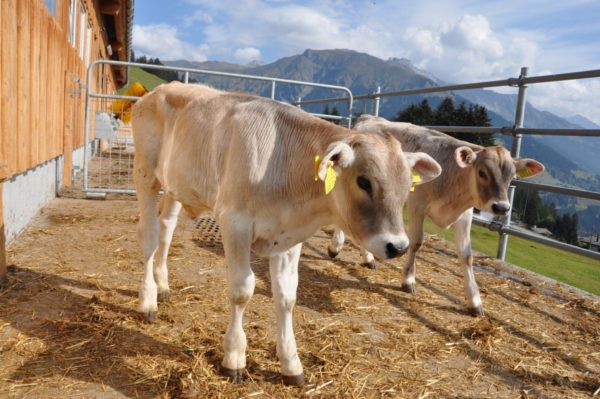

Calves need special attention
As you can see from the article, over the years of practice, scientists have developed a whole system of feeding cattle with many subtleties and nuances. For the successful cultivation of productive cattle, it is required to study the materials on this issue and strictly adhere to the recommendations, proportions, dosages. For those who have decided to make compound feed on their own, it is important to strictly observe the proportions and substances named in the recipe, because each ingredient has its own meaning.
Did you like the article? Save so as not to lose!
Nuances of diets
Drawing up normative nutrition schemes begins with an analysis of information related to a particular farm. The technique of creating rations involves taking into account such indicators as:
- Production purpose of animals, age, physiological state, as well as planned productivity.
- Composition and nutritional value of feed in relation to specific conditions.
- Farm plan for a certain period.
- Recommended feeding patterns in relation to the climatic region.
To understand how much hay a cow eats per year on a particular farm, you need to organize preparatory work on drawing up a nutrition plan. In the conditions of modern animal husbandry, it is more convenient to count on a computer using special programs. For this work, it will not hurt to know a brief description of existing types of diets with specific examples.
When fattening
Important
In this type of animal husbandry, an important indicator is the consumption of feed, spent on the increase of 1 kg of live weight for the average daily growing period. The normative value for fattening is at least 1000 grams per day.
There are three schemes, which are compiled taking into account the age of the cattle and the general terms of feeding:
- Meat bulls for 6-8 months are fattened a year to a weight of 500 kg.
- Feeding culled species.
- Weaning young calves 6-10 months.
In practice, it is most profitable to feed animals according to the first scheme. This will reduce the cost, since you can use inexpensive feed available on the farm: food waste, corn silage. The easiest way is to practice natural grazing, which makes it possible to obtain inexpensive and biologically correct meat.
In addition to nutrition, water is important. The optimal drinking regimen is 2-3 times a day. If feeding is thought out correctly, animals will show weight gain of up to 1,000 grams per day.
In winter, young meat should consume: 30% - roughage, 40% - succulent grasses, 30% - compound feed concentrate. The latter species by the end of feeding should be 40-50%. Due to the need for dietary changes, it is difficult to calculate how much compound feed a cow eats per day.
If the farmer's resources allow for waste from sugar factories, you can fatten juveniles on them. The pulp is useful both fresh and dry. According to the standards, it is needed by young individuals weighing 200-300 grams per day, 50 kg.
An example of a diet for 1.5-2 year old calves 1 head / day:
| Period: | Average daily weight supplements g: | Straw, kg | Silo, kg | Hay, kg | Bran, kg | Compound feed, kg | Salt, kg |
| Elementary | 950 | 3 | 30 | 1 | 0,3 | 1 | 30 |
| Middle | 1000 | 2 | 25 | 1 | 0,3 | 1,3 | 30 |
| Ending | 1000 | 1 | 20 | 2 | 0,3 | 1,6 | 35 |
For dairy cows
Milk productivity is formed due to the physiological processes of cattle.Proper care and adherence to nutritional standards will lead to high milk yield even for the most common cows. It is important to choose a diet in a timely manner that will enhance the genetic indicators for milk.
Of particular importance for milk yield will be the nutrition that the burenka received for lactation. The first 90 days after birth are most important for productivity.
To determine the needs of an animal, it is important to take into account age and fatness, milk yield per day, milk fat content. In the preparation of the diet, the required exchange energy is calculated.
The ratio of complete proteins to sugars and fats is also important. Cattle, weighing 500 kg, need to get about 15 kg of substances. It is more convenient to present the approximate nutrition of a dairy cow for lactation with a table:
| Amount of milk kg, day | Feed, units | Energy exchange mJ | Hay, kg | Haylage, kg | Silo, kg | Root crops, kg | Concentrates, kg | Mole, gr |
| 12-15 | 10-12 | 140 | 4 | 6 | 18 | 8 | 4 | 80 |
| 16-19 | 12-14 | 170 | 5 | 6 | 10 | 15 | 5 | 90 |
| 20 | 15 | 190 | 4 | 6 | 10 | 18 | 6 | 100 |
The same diet is also suitable for the cow after calving.
In the dry period
This is an important time, during which not only the health of the fetus is formed, but also milk yield. Future lactation can be prepared by competent feeding.
The standard time for the launch period is 45-60 days. In order not to reduce milk yield, juicy feed and concentrates should be removed from the cow's menu.
The main composition of the diet is determined by seasonality. For example, in winter it is optimal to give legumes and cereals, corn silage, haylage. The optimal organization of a watering hole with warm water 2-3 times a day is suitable. If the dry period occurs in the summer, only grass remains in the diet.
Approximate data for dry cattle:
| Standardized milk yield, kg | Feed units | Energetic. value of mj. | Silo, kg | Haylage, kg | Hay, kg | Tuberous fruits, kg | Concentrated feed, kg | Salt, g |
| 3000 | 9 | 90 | 12 | 6 | 4 | 4 | 1,5 | 50 |
| 4000 | 10 | 100 | 12 | 7 | 4 | 4 | 2 | 60 |
| 5000 | 12 | 120 | 12 | 7 | 4 | 4 | 2,5 | 70 |
In preparation for pregnancy
During this period, 10 days before the expected event, haylage and silage should be excluded from the diet. On the day of calving, clean the concentrates and give 2-3 days after calving. In order not to cause premature birth or other negative consequences in the cow, exclude low-quality feed from the diet. Provided a competent approach to business, complications will not arise.
Feeding of the same type - disadvantages
This technology assumes the distribution of feed to livestock in the form of a general mixed ration, regardless of seasonality and other indicators. Many livestock breeders still maintain the same type of diet today. However, in the future, production receives such disadvantages as:
- the need to increase the acreage for corn, legumes;
- difficulties with tracking the completeness of the diet.
An important condition for a system of the same type is the quality and nutritional value of the harvested grass. In addition to her, vitamin supplements must be correctly used in the daily diet. The transition to the same type of food system often results in serious economic losses - cows experience miscarriages and lower milk yield. The main disadvantage is the impossibility of realizing the genetic potential of animals.


